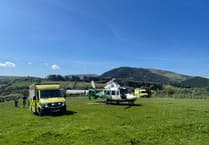The welfare of thoroughbred horses involved in the horse racing industry has been a concern for as long as the sport has existed, but last weekend’s Grand National race at Aintree has rekindled the debate quite dramatically.
An animal rights protest group called Animal Rising (linked to Extinction Rebellion) organized up to 300 protestors from around the UK to descend upon the racecourse aiming to disrupt, if not cause the cancellation of, the Grand National race on Saturday afternoon.
Merseyside Police and the Aintree racecourse organisers were well aware of the protest, but were unable to prevent a number of protesters from trying to fix themselves to fences and railings.
This caused a 14-minute delay to the start of the race, which some people claim caused the death of a ten-year-old horse called Hill Sixteen, who fell at the first fence.
He broke his neck and had to be humanely destroyed. A further 18 horses fell, with two taken away in a horse ambulance.
Hill Sixteen’s trainer claimed that uncertainty over the start of the race caused his horse to become ‘hyper’, and that this is why he fell to his death.
This may be true, and a terrible consequence of the Animal Rising protest, but this year’s race may well be the catalyst for further changes to the Grand National – a race that has caused the death of 16 horses since 2000 (with 62 horses dying during this period in other races over the same jumps).
The Grand National race attracts 500million viewers from across the world, due in large part to its reputation for being the toughest jump race in the UK.
A description of the infamous Chair fence on grandnational.org.uk says that ‘upon jumping a six-foot wide ditch and scaling a five-foot, two-inch fence, the turf on the other side is raised by six inches.
After having stretched to get over the ditch, horses are surprised to find the ground coming up to meet them.
This is spectacular when horses get it right and, for all the wrong reasons, when they don’t.
In 2012, flowing the death of two horses in the race, changes were made to the start (which was moved further away from the crowds) and to some of the jumps, in particular Becher’s Brook.
Landing areas were evened out and the central core of the fences was softened.
But the RSPCA wants there to be more change and is calling for the number of starters, which can be up to 40, to be reduced.
Fewer starters will give jockeys more room for manoeuvre, and will lessen the impact that loose horses have on those still in the race.
There is no doubt that the horses running in Saturday’s race were well cared for as expensive and valuable horses, but what goes on behind the scenes still requires much more scrutiny – and a UK-based charity called Animal Aid (www.animalaid.org.uk) has been trying to shed light on what happens to many horses once their racing career is over.
The charity has highlighted the hundreds of ex-racehorses being slaughtered in UK abattoirs, sometimes with questionable welfare standards.
The British Horseracing Authority (BHA) has a code of practice that the euthanasia of a racehorse should be performed either at the horse’s stable yard or in nearby suitable surroundings.
But policing this rule is not easy, despite CCTV being mandatory in British abattoirs.
The racing industry needs to take far more responsibility for horse ‘wastage’ – ie what happens to horses who can’t race.
A far bigger percentage of the billions of pounds generated by the sport should be directed towards retraining and rehabilitation of racehorses, so that they can go on to live lives as riding horses.
This is already being done on a limited basis by the charity Retraining of Racehorses (www.ror.org.uk) which tries to match up ex-racers with new owners in a range of disciplines, from dressage to polo.
If you’re looking for your next horse, then please consider one from the RoR website, but tread carefully because thoroughbreds need experienced homes and comprehensive insurance cover.

.png?width=209&height=140&crop=209:145,smart&quality=75)
.jpeg?width=209&height=140&crop=209:145,smart&quality=75)


Comments
This article has no comments yet. Be the first to leave a comment.